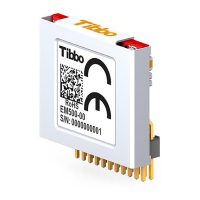167 Programmable Hardware Manual (PHM)
© Tibbo Technology Inc.
A/D Converter
The A/D converter is based on the Analog Devices' 24-bit AD7712 chip and has 8
independent channels.
Each channel has two differential input lines. Maximum input range is +/-10V. The
range can be adjusted to 1/2, 1/4, ... 1/128 of that by programming the internal
gain of the A/D circuit to 2, 4, ...128. With the gain of 1 and with bipolar mode
selected , applying +10V to the A/D input produces the conversion result of "all 1's".
Applying -10V produces "all 0's". Applying 0V produces "1" followed by 0's (this is a
"middle" value). Of course, this explanation is idealized as it doesn't take into
account inevitable conversion errors.
The A/D converter is designed for relatively slow, but highly accurate
measurements. With recommended configuration (see below), the converter will
produce 250 measurements/second for any selected channel. Only one channel can
be selected at any given time.
The A/D converter has full galvanic isolation from the rest of the IB1004 + SB1004
circuitry: the power for the A/D section is generated by an isolated switching power
supply, all control lines use opto-couplers.
A/D inputs
The A/D converter inputs are available on terminal blocks 1 and 2.
Terminal block 1:
A/D channel 4, negative input (-)
A/D channel 4, positive input (+)
A/D channel 3, negative input (-)
A/D channel 3, positive input (+)
A/D channel 2, negative input (-)
A/D channel 2, positive input (+)
A/D channel 1, negative input (-)
A/D channel 1, positive input (+)
A/D GROUND (isolated from the rest of the device)
Terminal block 2:
A/D channel 8, negative input (-)
A/D channel 8, positive input (+)
A/D channel 7, negative input (-)
A/D channel 7, positive input (+)
A/D channel 6, negative input (-)
A/D channel 6, positive input (+)
A/D channel 5, negative input (-)
A/D channel 5, positive input (+)
A/D GROUND (isolated from the rest of the device)

